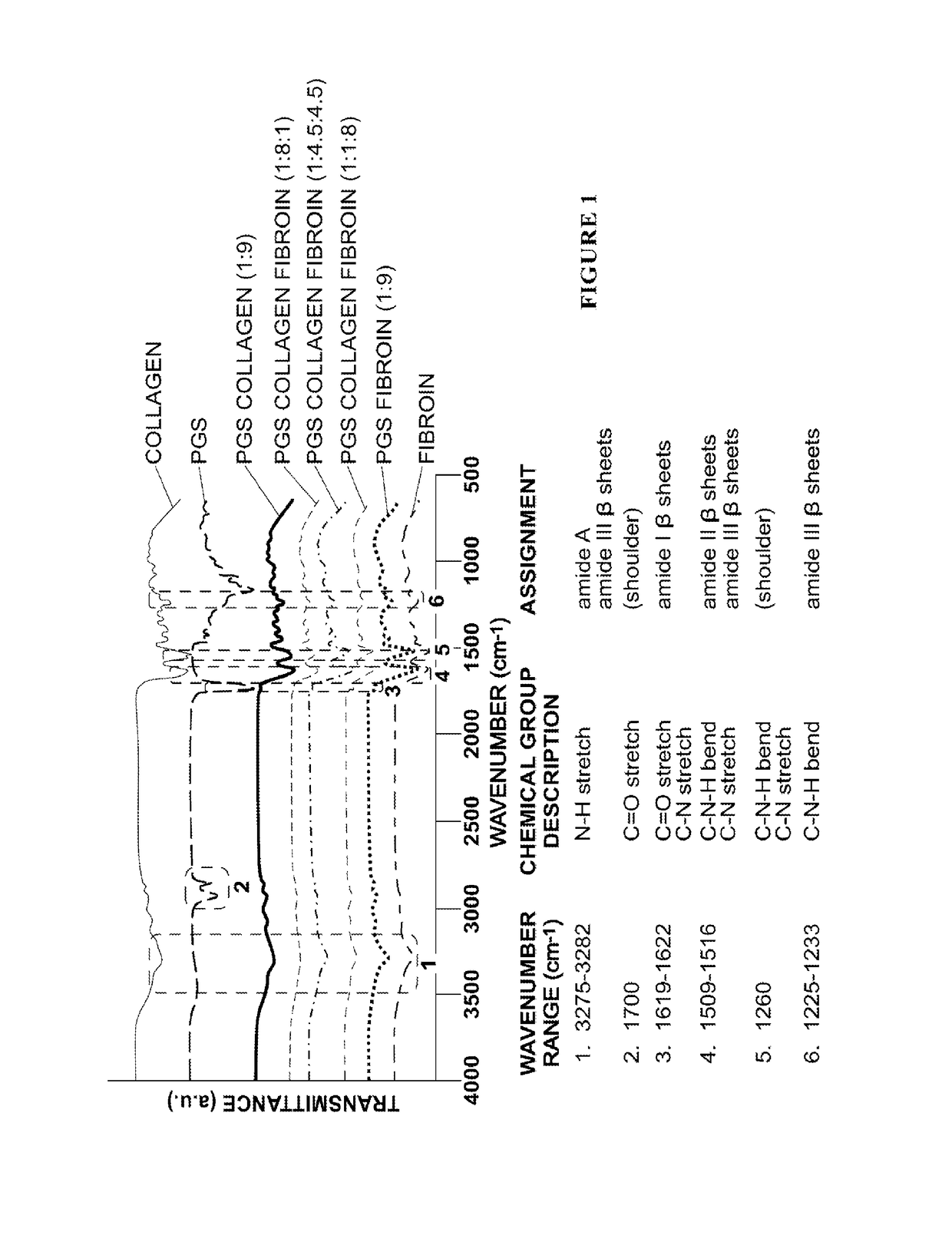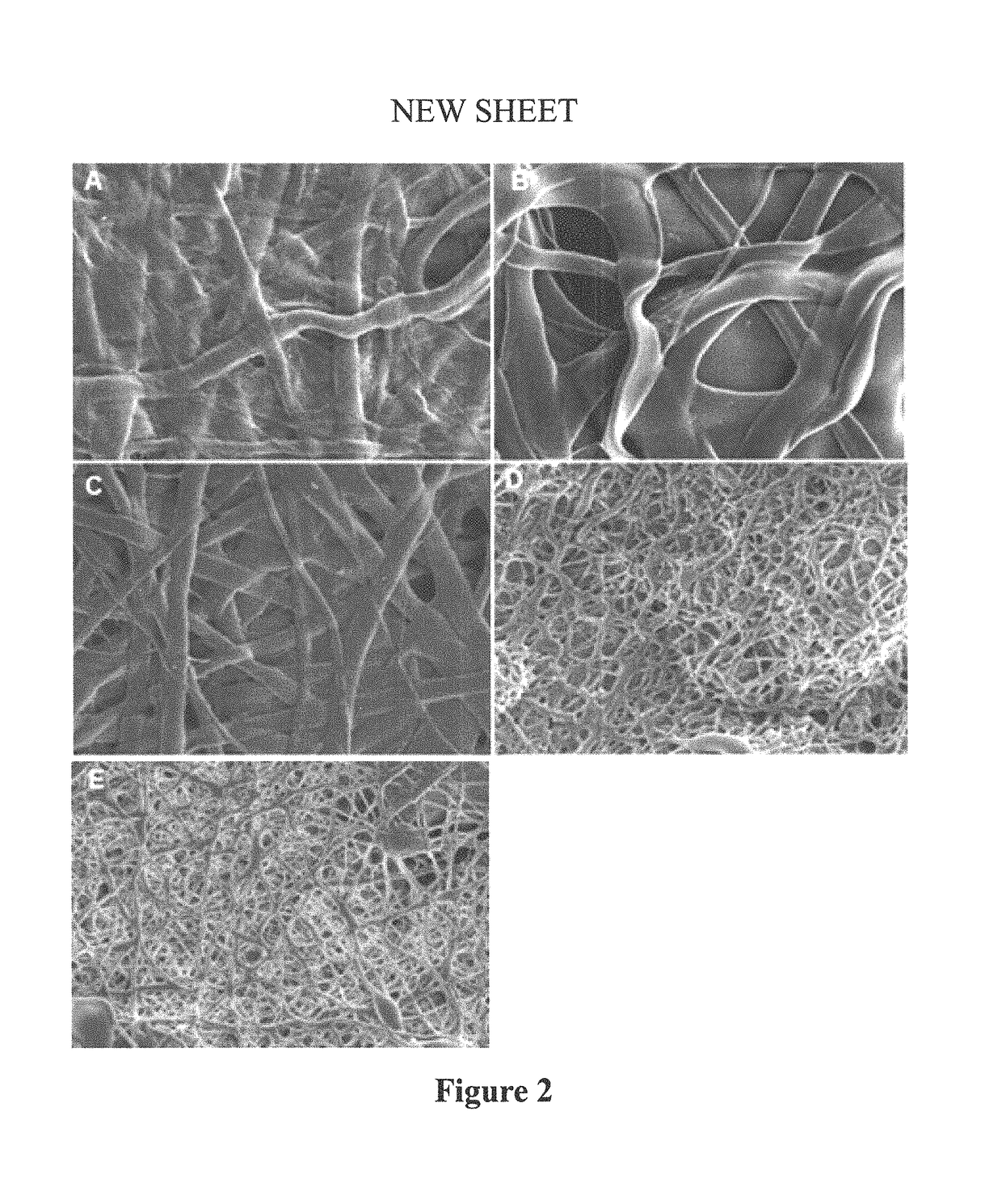Nanofiber-based graft for heart valve replacement and methods of using the same
a technology of nanofibers and heart valves, applied in the field of electro-optical nanofiber biomaterials, can solve the problems of life-threatening dysfunctional heart valves, early valve degeneration, and need life-long anti-coagulant therapy, and achieve the effects of reducing thrombogenic potential, reducing thrombogenic potential, and improving thrombolytic potential
- Summary
- Abstract
- Description
- Claims
- Application Information
AI Technical Summary
Benefits of technology
Problems solved by technology
Method used
Image
Examples
example 1
Composite Characterization
[0092]The blending of materials in composite nanofibers is initially demonstrated. For the extracted fibroin, FTIR spectroscopy indicated amide I, II, III groups were in the β sheet conformation based on wavenumbers corresponding to the carbonyl stretchs 1619-1622 cm−1, 1509-1516 cm−1, and 1225-1233 cm−1 respectively [23-24]. The wavenumber ranging from 3275-3282 cm−1 was indicative of the —N—H stretching vibration shown as a broad peak for amide A. An absorption peak of 1700 cm−1 was assigned to be the C═O stretch in amide I β sheets, and 1225-1233 cm−1 referred to the C—N stretch and C—N—H bend in amide III β sheets structure (Hu et al. 2006; Hayashi et al. 2007). Two strong peaks were shown at the regions of 1619-1622 cm−1 for C═O stretch of amide I and 1509-1516 cm−1 for the C—N stretch and C—N—H bend for amide II (Horan et al. 2005). (FIG. 1). Type I collagen had a characteristic broad peak at the absorption of 3275 cm−1 which was indicative for the —O...
example 2
Fiber Morphology
[0093]Fiber diameters ranged from 694 to 4577 nm (Table 1). In general, thinner and more rounded fibers were observed for the electrospun mats with higher fibroin content (90% and 80%) as compared to the thicker and more flat fiber of electrospun mats with high proportions of collagen (90%, 80%, and 45%). The interconnected fiber network structures of electrospun mats at various collagen, fibroin and PGS weight ratios were compared after crosslinking using scanning electron microscopy (SEM) (FIG. 2).
[0094]
TABLE 1Fiber Diameters in Mats of Different CompositionsSample TypeFiber Diameters (nm)Collagen:PGS (9:1)2067 ± 168Collagen:Fibroin:PGS (8:1:1)4577 ± 697Collagen:Fibroin:PGS (4.5:4.5:1)2952 ± 240Collagen:Fibroin:PGS (1:8:1)784 ± 77Fibroin:PGS (9:1)694 ± 43All values represent means ± SEM;The fiber diameters were measured from 16 randomly selected fibers of two representative SEM pictures. The measurements are presented as mean ± standard error of the mean.
example 3
Thermal Transition Analysis of Electrospun Mats
[0095]Results of DSC scan were analyzed to determine thermal transition temperatures of electrospun mats (FIG. 3). By incorporating an increasing amount of fibroin, a shift of thermal transition temperature to higher range was observed. The electrospun composite materials exhibit much higher thermal transition temperatures as compared to PGS alone. Results suggest the electrospun mats made from collagen, silk fibroin, and PGS composites were thermally stable for in vivo application.
PUM
| Property | Measurement | Unit |
|---|---|---|
| diameter | aaaaa | aaaaa |
| diameter | aaaaa | aaaaa |
| thick | aaaaa | aaaaa |
Abstract
Description
Claims
Application Information
 Login to View More
Login to View More - R&D
- Intellectual Property
- Life Sciences
- Materials
- Tech Scout
- Unparalleled Data Quality
- Higher Quality Content
- 60% Fewer Hallucinations
Browse by: Latest US Patents, China's latest patents, Technical Efficacy Thesaurus, Application Domain, Technology Topic, Popular Technical Reports.
© 2025 PatSnap. All rights reserved.Legal|Privacy policy|Modern Slavery Act Transparency Statement|Sitemap|About US| Contact US: help@patsnap.com



